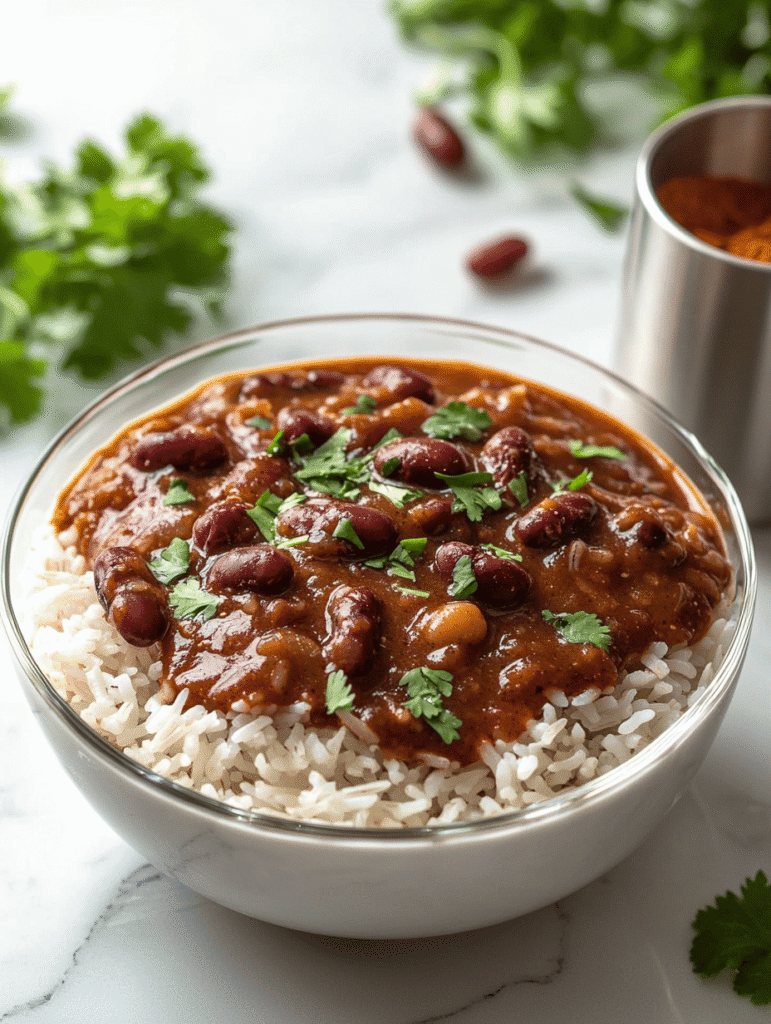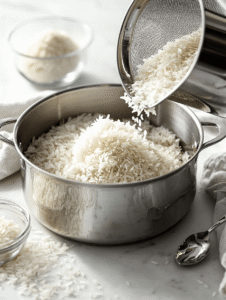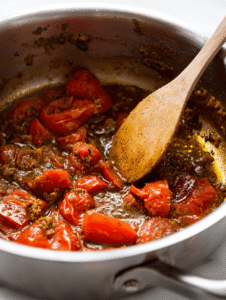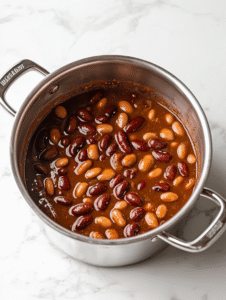Few dishes can evoke the warmth of home quite like Rajma Rice. I first encountered this North Indian classic at a local Indian restaurant in the United States, where the aroma of slow-cooked red kidney beans in a spiced tomato gravy paired with fluffy basmati rice instantly captured my heart.
Inspired, I decided to recreate it in my own kitchen—a labor of love that now fills my home with the same comforting aroma and nostalgia.
This hearty, protein-packed dish is a staple across North India, often served at family dinners or festive gatherings. Its rich flavors and satisfying texture make it a perfect comfort meal.
For a complete spread, pair it with Beet Salad with Feta, Cucumbers & Dill or a side of Au Gratin Potatoes to balance the spices and create a wholesome dining experience that’s both nourishing and indulgent.
Essential Ingredients for Rajma Rice
Every ingredient in Rajma Rice has a purpose. Kidney beans provide creamy protein and body, while basmati rice forms a fragrant, fluffy base.
Aromatics like onion, garlic, and ginger build depth, tomatoes give sweetness and acidity, and spices — cumin, coriander, turmeric, and garam masala — create the signature North Indian flavour. Prepping the ingredients ahead makes the cooking process seamless and ensures a rich, balanced dish every time.
Red Kidney Beans (1 cup, soaked overnight): The main protein of the dish, offering a creamy texture and earthy flavor once cooked. Soaking overnight reduces cooking time and ensures tender beans.
Basmati Rice (1.5 cups): Long-grain basmati rice provides a fragrant, fluffy base that pairs perfectly with the spiced kidney beans. Rinsing it removes excess starch for separate, non-sticky grains.
Oil or Ghee (2 tbsp): Used to sauté aromatics, giving the dish richness and depth of flavor. Ghee adds a traditional nutty aroma.
Onion (1 large, finely chopped): Forms the sweet, caramelized base of the curry.
Garlic (2 cloves, minced) & Ginger (1 inch, grated): Aromatic ingredients that add warmth and complexity.
Tomatoes (2 medium, pureed or chopped): Provide acidity and body to the curry, balancing the richness of the beans and spices.
Spices (1 tsp cumin, 1 tsp coriander powder, ½ tsp turmeric, 1 tsp garam masala): These combine to build classic North Indian flavor notes—earthy, aromatic, and slightly warm.
Water (2 cups) & Salt (to taste): Essential for cooking the beans and rice, and for adjusting seasoning in the final dish.
How To Make Perfect Rajma Rice: Step By Step Guide
Step 1: Cook the kidney beans
Drain the soaked beans and add them to a pressure cooker with 3 cups of water. Cook until soft, about 20–25 minutes. Once tender, set aside.
Step 2: Prepare the basmati rice
Rinse the rice thoroughly under cold running water until the water runs clear. Cook it in a separate pot with 2 cups of water until fluffy and the grains are separate, around 10–12 minutes. Fluff the rice with a fork and keep aside.
Step 3: Sauté aromatics
Heat oil or ghee in a skillet over medium heat. Add chopped onions and sauté until golden brown and aromatic, about 8 minutes. Add minced garlic and grated ginger; cook for 1–2 minutes until fragrant.
Step 4: Build the masala
Stir in pureed or chopped tomatoes along with cumin, coriander powder, and turmeric. Cook for 7–8 minutes until the mixture thickens and the oil begins to separate, releasing a rich, fragrant aroma.
Step 5: Combine beans and masala
Add the cooked kidney beans and 2 cups of water to the masala. Bring to a gentle boil, then reduce heat and simmer uncovered for 15 minutes until the gravy thickens slightly and beans are fully tender. Season with salt to taste.
Step 6: Serve and garnish
Layer the cooked rice over the bean gravy or serve the beans alongside the rice. Sprinkle garam masala on top and garnish with fresh herbs if desired. Serve hot for a wholesome, satisfying meal.
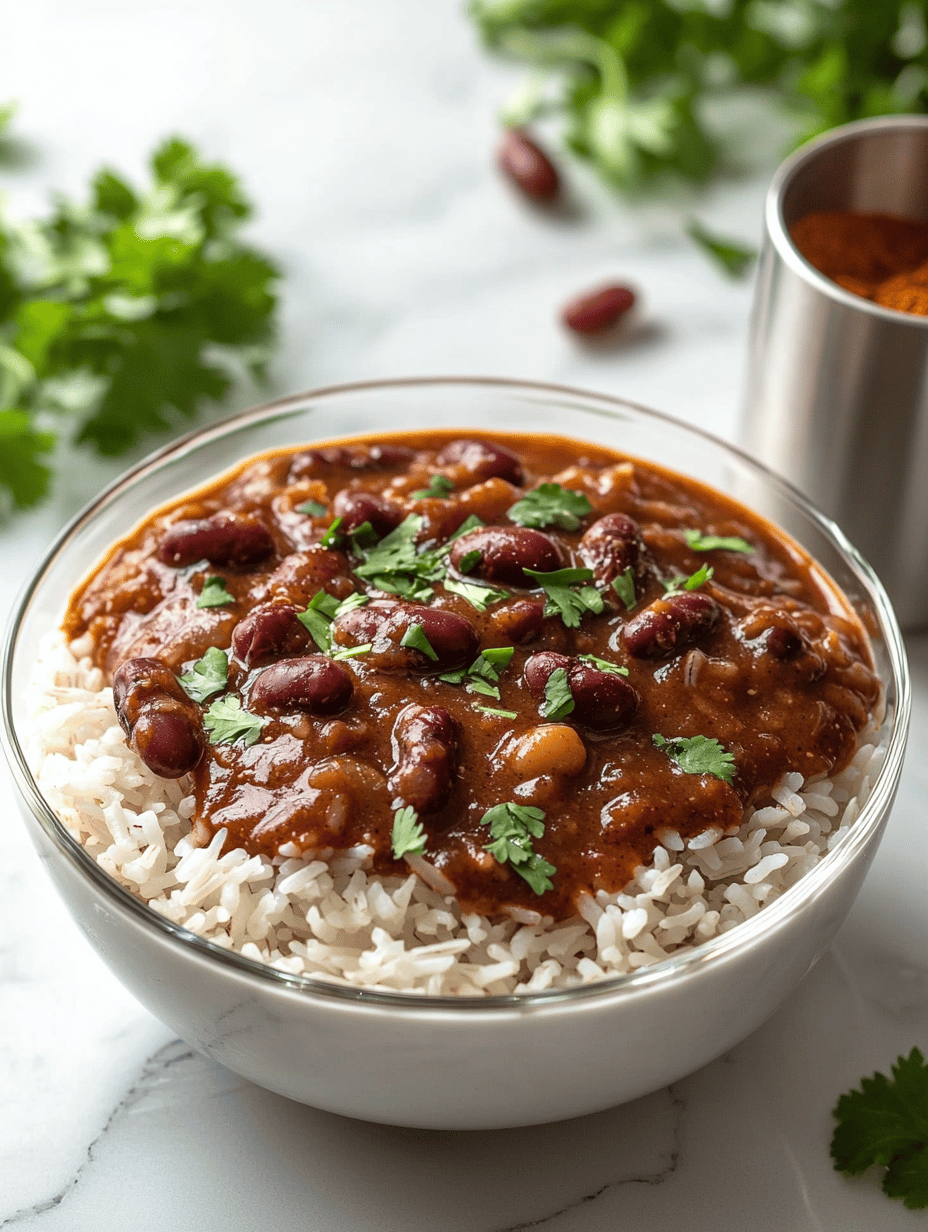
Rajma Rice
Ingredients
Equipment
Method
- Drain soaked kidney beans and cook them in a pressure cooker with 3 cups of water until soft, about 20-25 minutes. Set aside.1.5 cups basmati rice

- Rinse basmati rice thoroughly under cold water until the water runs clear. Cook the rice in a pot with 2 cups of water until fluffy and separate, around 10-12 minutes. Fluff with a fork and set aside.1.5 cups basmati rice

- Heat oil or ghee in a skillet over medium heat. Add chopped onions and sauté until golden brown, about 8 minutes, releasing a sweet aroma.1.5 cups basmati rice

- Add minced garlic and grated ginger to the skillet; cook until fragrant, about 1-2 minutes.1.5 cups basmati rice

- Stir in pureed or chopped tomatoes along with ground cumin, coriander powder, and turmeric. Cook until the mixture thickens and oil begins to separate from the masala, approximately 7-8 minutes, with bubbling sounds and a fragrant smell.1.5 cups basmati rice

- Add cooked kidney beans and water to the masala. Bring to a boil, then reduce heat and simmer uncovered for 15 minutes, until the gravy thickens slightly and beans are tender. Season with salt.1.5 cups basmati rice

- Layer the cooked rice over the bean gravy or serve the beans on the side. Sprinkle garam masala over the dish and garnish with fresh herbs if desired.1.5 cups basmati rice

Smart Substitutions to Make Rajma Rice Your Own
One of the best things about Rajma Rice is its flexibility. While the traditional recipe calls for red kidney beans and basmati rice, you can easily adapt it to what you have on hand or to suit your dietary needs:
- Beans: If you don’t have red kidney beans, black beans or pinto beans work well as alternatives. For a lighter version, chickpeas (chole) can also be used, though the flavour will be slightly different.
- Rice: Classic basmati rice gives the dish its authentic aroma, but you can swap it with Instant Pot Calrose Rice or even Simple White Rice for convenience. Brown rice is another great option for those looking to add more fibre.
- Spices: Don’t have garam masala? Use a mix of ground cumin, coriander, and a touch of cinnamon for a close alternative.
- Tomatoes: Fresh tomatoes give a vibrant flavour, but canned tomatoes or even tomato purée can save time without compromising taste.
- Vegan/Dairy-Free Option: Traditionally, some people finish the gravy with a dollop of cream or butter. You can swap it with coconut milk or cashew cream for a rich, dairy-free alternative.
These simple swaps ensure you never have to skip out on a comforting bowl of Rajma Rice, no matter what’s in your pantry.
Storing Rajma Rice the Right Way
Rajma Rice often tastes even better the next day as the flavours deepen and mingle, making leftovers a real treat. To store it properly and keep it safe for reheating:
- Separate Before Storing: For best results, store the rajma (bean curry) and rice in separate airtight containers. This prevents the rice from becoming mushy.
- Refrigeration: Both the curry and rice keep well in the fridge for up to 3 days. Make sure they are cooled to room temperature before storing.
- Freezing Option: Rajma freezes beautifully! Portion the curry into freezer-safe boxes and store for up to 2 months. Rice, however, is best enjoyed fresh or refrigerated — freezing can change its texture.
- Reheating: Warm the curry on the stovetop with a splash of water to loosen the gravy. For rice, sprinkle a little water over it before reheating in the microwave or steamer to bring back its fluffiness.
A little planning goes a long way—store smartly, and you’ll always have a quick, wholesome meal ready to go without compromising on taste.

Hi, I’m Anjali Arora — the curious heart behind Feast Chase.
To be honest, I’ve always felt most at ease in my own company. I’m not exactly a people-person (small talk still makes me cringe), but there are two things I’ve always loved deeply: animals and food.
